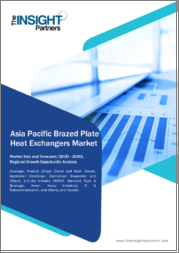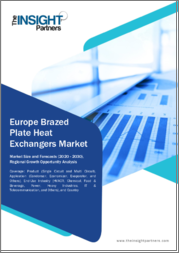
|
시장보고서
상품코드
1606271
세계의 브레이즈드 플레이트 열교환기 시장 : 유형별, 용도별 - 예측(2025-2030년)Brazed Plate Heat Exchangers Market by Type (Dual-circuit Brazed Plate Heat Exchangers, Dual-over-two-pass Brazed Plate Heat Exchangers, Two-pass Brazed Plate Heat Exchangers), Application (Condenser, Economizer, Evaporator) - Global Forecast 2025-2030 |
||||||
브레이즈드 플레이트 열교환기 시장은 2023년에 9억 4,276만 달러로 평가되었고, 2024년에는 9억 8,834만 달러로 추정되며, CAGR 6.90%로 성장할 전망이고, 2030년에는 15억 483만 달러에 도달할 것으로 예상됩니다.
브레이즈드 플레이트 열교환기는 소형 고효율 장치이며 일반적으로 혼합하지 않고 두 유체 사이에 열을 전달하는 데 사용됩니다. 브레이즈드 플레이트 열교환기는 여러 개의 얇은 판을 납땜한 것으로 유체가 흐르는 유로를 만들어 효과적인 열전달을 촉진합니다. 브레이즈드 플레이트 열교환기의 필요성은 HVAC 시스템, 냉동, 화학처리, 발전, 석유 및 가스 산업 등 종래의 열교환기와 비교하여 컴팩트한 사이즈, 높은 열효율, 저비용이므로 그 용도가 넓어지고 있는 것에 기인합니다. 이 시장은, 에너지 효율이 높은 솔루션에 대한 수요의 증가, 기술의 진보, 산업 운영에서 용도의 확대에 의해 성장을 이루고 있습니다. 특히 지속 가능한 에너지 솔루션으로의 전환은 지열 및 태양열 용도에서 이러한 열교환기의 수요를 촉진하고 있습니다. 최종 용도의 범위는 광대하며, 전술 외에 식음료, 제약, 해양 산업 등의 분야를 커버하고 있습니다. 주요 성장 요인으로는 에너지 절약에 대한 관심 증대, 열교환기의 효율을 높이는 기술 혁신, 신흥 시장에서의 산업 용도 확대 등을 들 수 있습니다. 신재생 에너지 용도의 확대나, 전열 효율의 향상과 비용 효율이 높은 재료의 개발에 의한 새로운 산업 용도를 위한 교환기의 개발에는 비즈니스 찬스가 있습니다. 그러나 시장의 성장은 높은 초기 비용, 복잡한 유지보수 요건, 셸 및 튜브식이나 플레이트 및 프레임식 등의 다른 유형의 열교환기와의 경합과 같은 과제에 직면해 있습니다. 연구에 대한 투자는, 재료의 내구성, 내부식성의 강화, 보다 환경 친화적인 냉매의 개발이라고 하는 분야에서의 기술 혁신을 촉진해, 시장의 확대와 효율화를 도모할 수 있습니다. 시장의 경쟁은 완만하고, 비용 효율을 혁신하고, 새로운 환경 규제에 적응할 수 있는 신규 참가자에게 기회가 있습니다. 비용 절감과 함께 지속 가능성과 성능의 최적화를 중시하는 것은 시장 기회를 살리는데 매우 중요합니다.
| 주요 시장 통계 | |
|---|---|
| 기준년(2023년) | 9억 4,276만 달러 |
| 추정년(2024년) | 9억 8,834만 달러 |
| 예측년(2030년) | 15억 483만 달러 |
| CAGR(%) | 6.90% |
시장 역학 : 급속히 진화하는 브레이즈드 플레이트 열교환기 시장의 주요 시장 인사이트 공개
브레이즈드 플레이트 열교환기 시장은 수요 및 공급의 역동적인 상호 작용에 의해 변모를 이루고 있습니다. 이러한 시장 역학의 진화를 이해하는 것으로, 기업은 충분한 정보에 근거한 투자 결정, 전략적 의사 결정, 새로운 비즈니스 찬스의 획득을 실시할 수 있습니다. 이러한 동향을 포괄적으로 파악함으로써 기업은 정치적, 지리적, 기술적, 사회적, 경제적인 영역에 걸친 다양한 리스크를 경감할 수 있는 동시에 소비자 행동과 그것이 제조 비용이나 구매 동향에 미치는 영향을 보다 명확하게 이해할 수 있습니다.
- 시장 성장 촉진요인
- HVACR 시스템에서의 채용 확대
- 기존 및 개수 주택, 경상용 건축 증가
- 시장 성장 억제요인
- 열교환기의 수리 및 서비스에는 전문적인 지식과 설비가 필요
- 시장 기회
- 설계 및 구조면에서의 기술 진보
- 제로 에미션 규제의 실시
- 시장의 과제
- 오염, 부식에 관한 문제
Porter's Five Forces : 브레이즈드 플레이트 열교환기 시장을 탐색하는 전략 도구
Porter's Five Forces 프레임워크는 시장 상황의 경쟁 구도를 이해하는 중요한 도구입니다. Porter's Five Forces 프레임워크는 기업의 경쟁력을 평가하고 전략적 기회를 탐구하는 명확한 기술을 제공합니다. 이 프레임워크는 기업이 시장 내 세력도를 평가하고 신규 사업의 수익성을 결정하는 데 도움이 됩니다. 이러한 인사이트를 통해 기업은 자사의 강점을 활용하고, 약점을 해결하고, 잠재적인 과제를 피할 수 있으며, 보다 강인한 시장에서의 포지셔닝을 보장할 수 있습니다.
PESTLE 분석 : 브레이즈드 플레이트 열교환기 시장에서 외부로부터의 영향 파악
외부 거시 환경 요인은 브레이즈드 플레이트 열교환기 시장의 성과 역학을 형성하는데 매우 중요한 역할을 합니다. 정치적, 경제적, 사회적, 기술적, 법적, 환경적 요인 분석은 이러한 영향을 탐색하는 데 필요한 정보를 제공합니다. PESTLE 요인을 조사함으로써 기업은 잠재적인 위험과 기회를 더 잘 이해할 수 있습니다. 이 분석을 통해 기업은 규제, 소비자 선호, 경제 동향의 변화를 예측하고 앞으로 예상되는 적극적인 의사 결정을 할 준비를 할 수 있습니다.
시장 점유율 분석 : 브레이즈드 플레이트 열교환기 시장에서 경쟁 구도 파악
브레이즈드 플레이트 열교환기 시장의 상세한 시장 점유율 분석을 통해 공급업체의 성과를 종합적으로 평가할 수 있습니다. 기업은 수익, 고객 기반, 성장률 등의 주요 지표를 비교함으로써 경쟁상의 포지셔닝을 밝힐 수 있습니다. 이 분석에 의해 시장의 집중, 단편화, 통합의 동향이 밝혀져 벤더는 경쟁이 격화되는 가운데 자사의 지위를 높이는 전략적 의사결정을 실시하기 위해 필요한 지견을 얻을 수 있습니다.
FPNV 포지셔닝 매트릭스 : 브레이징 플레이트 열 교환기 시장에서 공급업체의 성능 평가
FPNV 포지셔닝 매트릭스는 브레이즈드 플레이트 열교환기 시장에서 벤더를 평가하는 중요한 도구입니다. 이 매트릭스를 통해 비즈니스 조직은 공급업체의 비즈니스 전략과 제품 만족도를 기준으로 평가하여 목표에 맞는 충분한 정보를 바탕으로 의사 결정을 내릴 수 있습니다. 네 가지 사분면을 통해 공급업체를 명확하고 정확하게 세분화하여 전략 목표에 가장 적합한 파트너 및 솔루션을 파악할 수 있습니다.
전략 분석 및 추천 : 브레이즈드 플레이트 열교환기 시장에서 성공을 위한 길을 그리기
브레이즈드 플레이트 열교환기 시장의 전략 분석은 세계 시장에서의 프레즌스 강화를 목표로 하는 기업에 필수적입니다. 이 주요 자원, 역량 및 성과 지표를 검토함으로써 기업은 성장 기회를 파악하고 개선을 위해 노력할 수 있습니다. 이러한 접근 방식을 통해 경쟁 구도에서 과제를 극복하고 새로운 비즈니스 기회를 활용하여 장기적인 성공을 거둘 수 있는 체제를 구축할 수 있습니다.
이 보고서는 주요 관심 분야를 포괄하는 시장의 종합적인 분석을 제공합니다.
1. 시장 침투 : 현재 시장 환경의 상세한 검토, 주요 기업의 광범위한 데이터, 시장 도달범위 및 전반적인 영향력을 평가합니다.
2. 시장 개척도 : 신흥 시장의 성장 기회를 파악하고 기존 분야의 확장 가능성을 평가하며 미래 성장을 위한 전략적 로드맵을 제공합니다.
3. 시장 다양화 : 최근 제품 출시, 미개척 지역, 업계의 주요 진보, 시장을 형성하는 전략적 투자를 분석합니다.
4. 경쟁 평가 및 정보 : 경쟁 구도를 철저히 분석하여 시장 점유율, 사업 전략, 제품 포트폴리오, 인증, 규제 당국 승인, 특허 동향, 주요 기업의 기술 진보 등을 검증합니다.
5. 제품 개발 및 혁신 : 미래 시장 성장을 가속할 것으로 예상되는 최첨단 기술, 연구개발 활동, 제품 혁신을 강조합니다.
또한 이해관계자가 충분한 정보를 얻고 의사결정을 할 수 있도록 중요한 질문에 대답하고 있습니다.
1. 현재 시장 규모 및 향후 성장 예측은?
2. 최고의 투자 기회를 제공하는 제품, 부문 및 지역은 어디입니까?
3. 시장을 형성하는 주요 기술 동향 및 규제의 영향은?
4. 주요 벤더의 시장 점유율 및 경쟁 포지션은?
5. 벤더 시장 진입 및 철수 전략의 원동력이 되는 수익원과 전략적 기회는 무엇인가?
목차
제1장 서문
제2장 조사 방법
제3장 주요 요약
제4장 시장 개요
제5장 시장 인사이트
- 시장 역학
- 성장 촉진요인
- HVACR 시스템에서의 채용 확대
- 기존 및 개수 주택과 경상업 시설의 건설 증가
- 억제요인
- 열교환기의 수리 및 유지보수에 필요한 전문 지식과 설비
- 기회
- 설계 및 건설에서 기술적 진보
- 제로 배출 규제 실시
- 과제
- 얼룩이나 부식에 관한 문제
- 성장 촉진요인
- 시장 세분화 분석
- Porter's Five Forces 분석
- PESTEL 분석
- 정치적
- 경제
- 사교
- 기술적
- 법률상
- 환경
제6장 브레이즈드 플레이트 열교환기 시장 : 유형별
- 듀얼 서킷 브레이즈드 플레이트 열교환기
- 듀얼 오버 투 패스 브레이즈드 플레이트 열교환기
- 2패스 브레이즈드 플레이트 열교환기
제7장 브레이즈드 플레이트 열교환기 시장 : 용도별
- 커패시터
- 이코노마이저
- 증발기
제8장 아메리카의 브레이즈드 플레이트 열교환기 시장
- 아르헨티나
- 브라질
- 캐나다
- 멕시코
- 미국
제9장 아시아태평양의 브레이즈드 플레이트 열교환기 시장
- 호주
- 중국
- 인도
- 인도네시아
- 일본
- 말레이시아
- 필리핀
- 싱가포르
- 한국
- 대만
- 태국
- 베트남
제10장 유럽, 중동 및 아프리카의 브레이즈드 플레이트 열교환기 시장
- 덴마크
- 이집트
- 핀란드
- 프랑스
- 독일
- 이스라엘
- 이탈리아
- 네덜란드
- 나이지리아
- 노르웨이
- 폴란드
- 카타르
- 러시아
- 사우디아라비아
- 남아프리카
- 스페인
- 스웨덴
- 스위스
- 터키
- 아랍에미리트(UAE)
- 영국
제11장 경쟁 구도
- 시장 점유율 분석(2023년)
- FPNV 포지셔닝 매트릭스(2023년)
- 경쟁 시나리오 분석
- 전략 분석 및 제안
기업 목록
- AAB Heat Exchangers Private Limited
- Advanced Industrial Components Inc.
- Alfa Laval AB
- API Heat Transfer
- Baffles cooling systems
- Chart Industries
- Danfoss SA
- Fluid Dynamics Pty Ltd
- Fortek
- Funke Warmetauscher Apparatebau GmbH
- HISAKAWORKS SEA SDN BHD
- Kelvion Holding GmbH
- Kobe Steel, Ltd
- Mason Manufacturing LLC
- Onda Spa
- Paul Mueller Company
- Process Engineers And Associates
- SAPHEX Limited
- SonFlow Australia Pty Ltd
- Sunrise Process Equipments
- SWEP International AB
- UNITED HEAT EXCHANGERS
- Wessels Company
- Western Canada Heat Exchanger Ltd.
- Xylem Inc.
The Brazed Plate Heat Exchangers Market was valued at USD 942.76 million in 2023, expected to reach USD 988.34 million in 2024, and is projected to grow at a CAGR of 6.90%, to USD 1,504.83 million by 2030.
Brazed plate heat exchangers are compact, highly efficient devices used for transferring heat between two fluids, usually without mixing them. They are composed of multiple thin plates that are brazed together, creating channels for the fluids to flow through, which facilitates effective heat transfer. The necessity for brazed plate heat exchangers is driven by their applications across HVAC systems, refrigeration, chemical processing, power generation, and oil and gas industries owing to their compact size, high thermal efficiency, and low cost compared to traditional heat exchangers. The market is seeing growth due to increased demand for energy-efficient solutions, technological advancements, and expanding applications in industrial operations. Notably, the shift towards sustainable energy solutions propels the demand for these exchangers in geothermal and solar thermal applications. The end-use scope is vast, covering sectors such as food and beverage, pharmaceutical, and marine industries, apart from the aforementioned. Key growth factors include the rising focus on energy conservation, technological innovations enhancing exchanger efficiency, and expanding industrial applications in emerging markets. Opportunities lie in expanding renewable energy applications and developing exchangers for new industrial use cases by enhancing heat transfer efficiency and developing cost-effective materials. However, market growth faces challenges like high initial costs, complex maintenance requirements, and competition from other heat exchanger types like shell and tube and plate and frame exchangers. Investment in research can drive innovation in areas such as enhancing material durability, corrosion resistance, and developing more environmentally friendly refrigerants to expand market reach and efficiency. The market is characterized by moderate competition with opportunities for new entrants who can innovate on cost-efficiency and adapt to emerging environmental regulations. Emphasizing sustainability and performance optimization alongside cost reduction is crucial for capitalizing on market opportunities.
| KEY MARKET STATISTICS | |
|---|---|
| Base Year [2023] | USD 942.76 million |
| Estimated Year [2024] | USD 988.34 million |
| Forecast Year [2030] | USD 1,504.83 million |
| CAGR (%) | 6.90% |
Market Dynamics: Unveiling Key Market Insights in the Rapidly Evolving Brazed Plate Heat Exchangers Market
The Brazed Plate Heat Exchangers Market is undergoing transformative changes driven by a dynamic interplay of supply and demand factors. Understanding these evolving market dynamics prepares business organizations to make informed investment decisions, refine strategic decisions, and seize new opportunities. By gaining a comprehensive view of these trends, business organizations can mitigate various risks across political, geographic, technical, social, and economic domains while also gaining a clearer understanding of consumer behavior and its impact on manufacturing costs and purchasing trends.
- Market Drivers
- Growing adoption in the HVACR system
- Rising existing and retrofit residential and light commercial construction
- Market Restraints
- Requirement of specialized knowledge and equipment for repairing or servicing the heat exchanger
- Market Opportunities
- Technological advancement in terms of design and construction
- Implementation of zero emission regulations
- Market Challenges
- Issues related to fouling, and corrosion
Porter's Five Forces: A Strategic Tool for Navigating the Brazed Plate Heat Exchangers Market
Porter's five forces framework is a critical tool for understanding the competitive landscape of the Brazed Plate Heat Exchangers Market. It offers business organizations with a clear methodology for evaluating their competitive positioning and exploring strategic opportunities. This framework helps businesses assess the power dynamics within the market and determine the profitability of new ventures. With these insights, business organizations can leverage their strengths, address weaknesses, and avoid potential challenges, ensuring a more resilient market positioning.
PESTLE Analysis: Navigating External Influences in the Brazed Plate Heat Exchangers Market
External macro-environmental factors play a pivotal role in shaping the performance dynamics of the Brazed Plate Heat Exchangers Market. Political, Economic, Social, Technological, Legal, and Environmental factors analysis provides the necessary information to navigate these influences. By examining PESTLE factors, businesses can better understand potential risks and opportunities. This analysis enables business organizations to anticipate changes in regulations, consumer preferences, and economic trends, ensuring they are prepared to make proactive, forward-thinking decisions.
Market Share Analysis: Understanding the Competitive Landscape in the Brazed Plate Heat Exchangers Market
A detailed market share analysis in the Brazed Plate Heat Exchangers Market provides a comprehensive assessment of vendors' performance. Companies can identify their competitive positioning by comparing key metrics, including revenue, customer base, and growth rates. This analysis highlights market concentration, fragmentation, and trends in consolidation, offering vendors the insights required to make strategic decisions that enhance their position in an increasingly competitive landscape.
FPNV Positioning Matrix: Evaluating Vendors' Performance in the Brazed Plate Heat Exchangers Market
The Forefront, Pathfinder, Niche, Vital (FPNV) Positioning Matrix is a critical tool for evaluating vendors within the Brazed Plate Heat Exchangers Market. This matrix enables business organizations to make well-informed decisions that align with their goals by assessing vendors based on their business strategy and product satisfaction. The four quadrants provide a clear and precise segmentation of vendors, helping users identify the right partners and solutions that best fit their strategic objectives.
Strategy Analysis & Recommendation: Charting a Path to Success in the Brazed Plate Heat Exchangers Market
A strategic analysis of the Brazed Plate Heat Exchangers Market is essential for businesses looking to strengthen their global market presence. By reviewing key resources, capabilities, and performance indicators, business organizations can identify growth opportunities and work toward improvement. This approach helps businesses navigate challenges in the competitive landscape and ensures they are well-positioned to capitalize on newer opportunities and drive long-term success.
Key Company Profiles
The report delves into recent significant developments in the Brazed Plate Heat Exchangers Market, highlighting leading vendors and their innovative profiles. These include AAB Heat Exchangers Private Limited, Advanced Industrial Components Inc., Alfa Laval AB, API Heat Transfer, Baffles cooling systems, Chart Industries, Danfoss SA, Fluid Dynamics Pty Ltd, Fortek, Funke Warmetauscher Apparatebau GmbH, HISAKAWORKS S.E.A SDN BHD, Kelvion Holding GmbH, Kobe Steel, Ltd, Mason Manufacturing LLC, Onda S.p.a, Paul Mueller Company, Process Engineers And Associates, SAPHEX Limited, SonFlow Australia Pty Ltd, Sunrise Process Equipments, SWEP International AB, UNITED HEAT EXCHANGERS, Wessels Company, Western Canada Heat Exchanger Ltd., and Xylem Inc..
Market Segmentation & Coverage
This research report categorizes the Brazed Plate Heat Exchangers Market to forecast the revenues and analyze trends in each of the following sub-markets:
- Based on Type, market is studied across Dual-circuit Brazed Plate Heat Exchangers, Dual-over-two-pass Brazed Plate Heat Exchangers, and Two-pass Brazed Plate Heat Exchangers.
- Based on Application, market is studied across Condenser, Economizer, and Evaporator.
- Based on Region, market is studied across Americas, Asia-Pacific, and Europe, Middle East & Africa. The Americas is further studied across Argentina, Brazil, Canada, Mexico, and United States. The United States is further studied across California, Florida, Illinois, New York, Ohio, Pennsylvania, and Texas. The Asia-Pacific is further studied across Australia, China, India, Indonesia, Japan, Malaysia, Philippines, Singapore, South Korea, Taiwan, Thailand, and Vietnam. The Europe, Middle East & Africa is further studied across Denmark, Egypt, Finland, France, Germany, Israel, Italy, Netherlands, Nigeria, Norway, Poland, Qatar, Russia, Saudi Arabia, South Africa, Spain, Sweden, Switzerland, Turkey, United Arab Emirates, and United Kingdom.
The report offers a comprehensive analysis of the market, covering key focus areas:
1. Market Penetration: A detailed review of the current market environment, including extensive data from top industry players, evaluating their market reach and overall influence.
2. Market Development: Identifies growth opportunities in emerging markets and assesses expansion potential in established sectors, providing a strategic roadmap for future growth.
3. Market Diversification: Analyzes recent product launches, untapped geographic regions, major industry advancements, and strategic investments reshaping the market.
4. Competitive Assessment & Intelligence: Provides a thorough analysis of the competitive landscape, examining market share, business strategies, product portfolios, certifications, regulatory approvals, patent trends, and technological advancements of key players.
5. Product Development & Innovation: Highlights cutting-edge technologies, R&D activities, and product innovations expected to drive future market growth.
The report also answers critical questions to aid stakeholders in making informed decisions:
1. What is the current market size, and what is the forecasted growth?
2. Which products, segments, and regions offer the best investment opportunities?
3. What are the key technology trends and regulatory influences shaping the market?
4. How do leading vendors rank in terms of market share and competitive positioning?
5. What revenue sources and strategic opportunities drive vendors' market entry or exit strategies?
Table of Contents
1. Preface
- 1.1. Objectives of the Study
- 1.2. Market Segmentation & Coverage
- 1.3. Years Considered for the Study
- 1.4. Currency & Pricing
- 1.5. Language
- 1.6. Stakeholders
2. Research Methodology
- 2.1. Define: Research Objective
- 2.2. Determine: Research Design
- 2.3. Prepare: Research Instrument
- 2.4. Collect: Data Source
- 2.5. Analyze: Data Interpretation
- 2.6. Formulate: Data Verification
- 2.7. Publish: Research Report
- 2.8. Repeat: Report Update
3. Executive Summary
4. Market Overview
5. Market Insights
- 5.1. Market Dynamics
- 5.1.1. Drivers
- 5.1.1.1. Growing adoption in the HVACR system
- 5.1.1.2. Rising existing and retrofit residential and light commercial construction
- 5.1.2. Restraints
- 5.1.2.1. Requirement of specialized knowledge and equipment for repairing or servicing the heat exchanger
- 5.1.3. Opportunities
- 5.1.3.1. Technological advancement in terms of design and construction
- 5.1.3.2. Implementation of zero emission regulations
- 5.1.4. Challenges
- 5.1.4.1. Issues related to fouling, and corrosion
- 5.1.1. Drivers
- 5.2. Market Segmentation Analysis
- 5.3. Porter's Five Forces Analysis
- 5.3.1. Threat of New Entrants
- 5.3.2. Threat of Substitutes
- 5.3.3. Bargaining Power of Customers
- 5.3.4. Bargaining Power of Suppliers
- 5.3.5. Industry Rivalry
- 5.4. PESTLE Analysis
- 5.4.1. Political
- 5.4.2. Economic
- 5.4.3. Social
- 5.4.4. Technological
- 5.4.5. Legal
- 5.4.6. Environmental
6. Brazed Plate Heat Exchangers Market, by Type
- 6.1. Introduction
- 6.2. Dual-circuit Brazed Plate Heat Exchangers
- 6.3. Dual-over-two-pass Brazed Plate Heat Exchangers
- 6.4. Two-pass Brazed Plate Heat Exchangers
7. Brazed Plate Heat Exchangers Market, by Application
- 7.1. Introduction
- 7.2. Condenser
- 7.3. Economizer
- 7.4. Evaporator
8. Americas Brazed Plate Heat Exchangers Market
- 8.1. Introduction
- 8.2. Argentina
- 8.3. Brazil
- 8.4. Canada
- 8.5. Mexico
- 8.6. United States
9. Asia-Pacific Brazed Plate Heat Exchangers Market
- 9.1. Introduction
- 9.2. Australia
- 9.3. China
- 9.4. India
- 9.5. Indonesia
- 9.6. Japan
- 9.7. Malaysia
- 9.8. Philippines
- 9.9. Singapore
- 9.10. South Korea
- 9.11. Taiwan
- 9.12. Thailand
- 9.13. Vietnam
10. Europe, Middle East & Africa Brazed Plate Heat Exchangers Market
- 10.1. Introduction
- 10.2. Denmark
- 10.3. Egypt
- 10.4. Finland
- 10.5. France
- 10.6. Germany
- 10.7. Israel
- 10.8. Italy
- 10.9. Netherlands
- 10.10. Nigeria
- 10.11. Norway
- 10.12. Poland
- 10.13. Qatar
- 10.14. Russia
- 10.15. Saudi Arabia
- 10.16. South Africa
- 10.17. Spain
- 10.18. Sweden
- 10.19. Switzerland
- 10.20. Turkey
- 10.21. United Arab Emirates
- 10.22. United Kingdom
11. Competitive Landscape
- 11.1. Market Share Analysis, 2023
- 11.2. FPNV Positioning Matrix, 2023
- 11.3. Competitive Scenario Analysis
- 11.4. Strategy Analysis & Recommendation
Companies Mentioned
- 1. AAB Heat Exchangers Private Limited
- 2. Advanced Industrial Components Inc.
- 3. Alfa Laval AB
- 4. API Heat Transfer
- 5. Baffles cooling systems
- 6. Chart Industries
- 7. Danfoss SA
- 8. Fluid Dynamics Pty Ltd
- 9. Fortek
- 10. Funke Warmetauscher Apparatebau GmbH
- 11. HISAKAWORKS S.E.A SDN BHD
- 12. Kelvion Holding GmbH
- 13. Kobe Steel, Ltd
- 14. Mason Manufacturing LLC
- 15. Onda S.p.a
- 16. Paul Mueller Company
- 17. Process Engineers And Associates
- 18. SAPHEX Limited
- 19. SonFlow Australia Pty Ltd
- 20. Sunrise Process Equipments
- 21. SWEP International AB
- 22. UNITED HEAT EXCHANGERS
- 23. Wessels Company
- 24. Western Canada Heat Exchanger Ltd.
- 25. Xylem Inc.
















